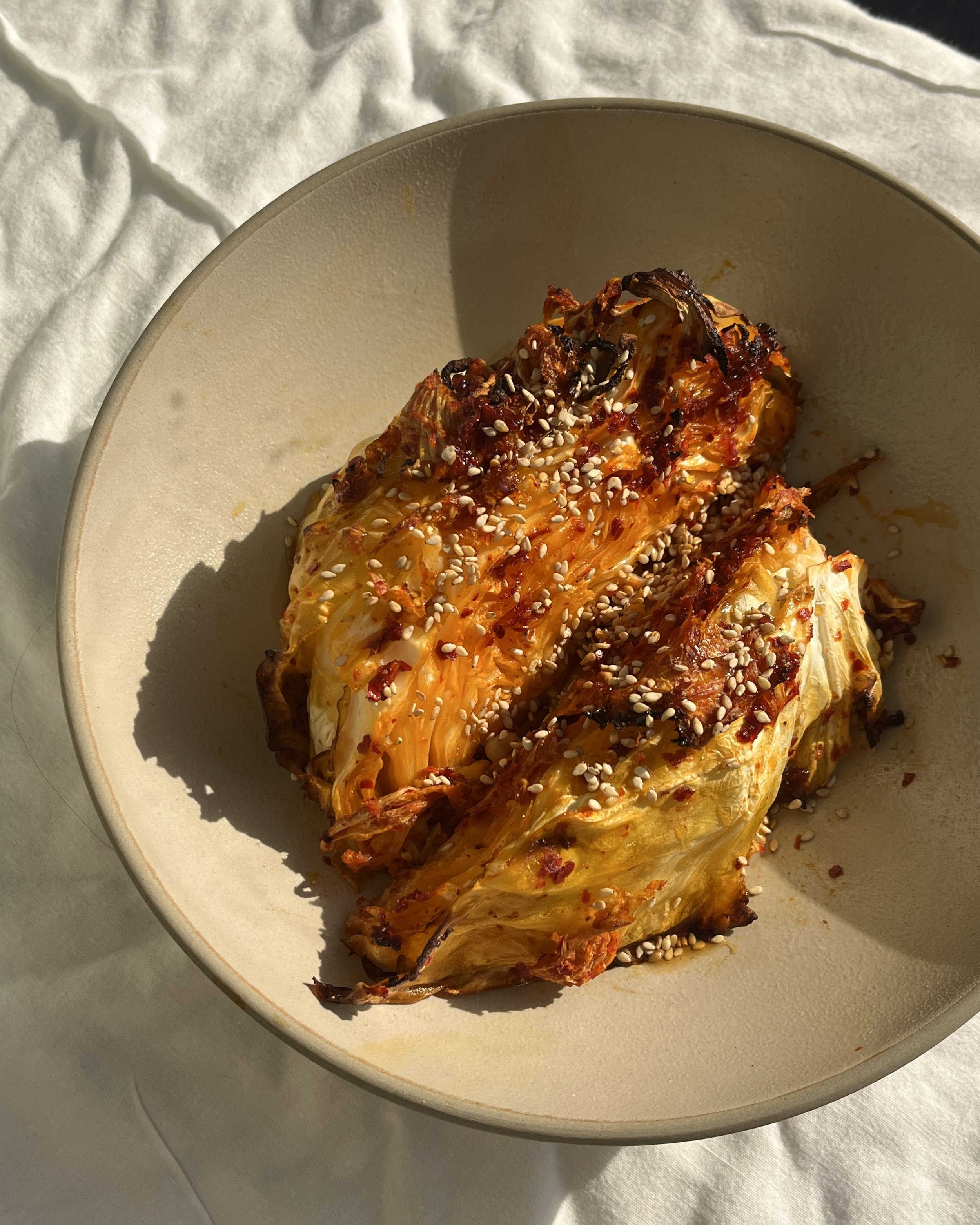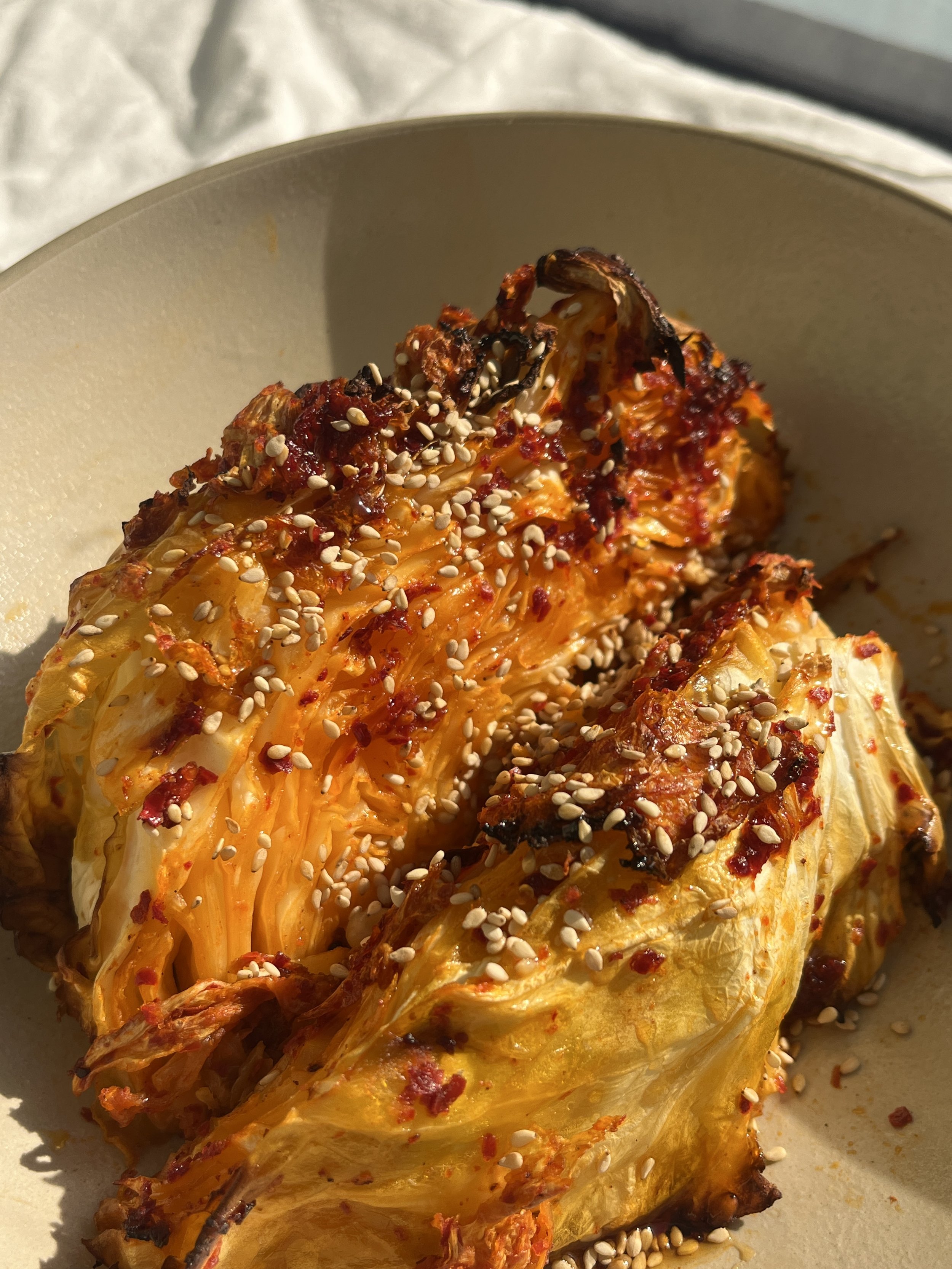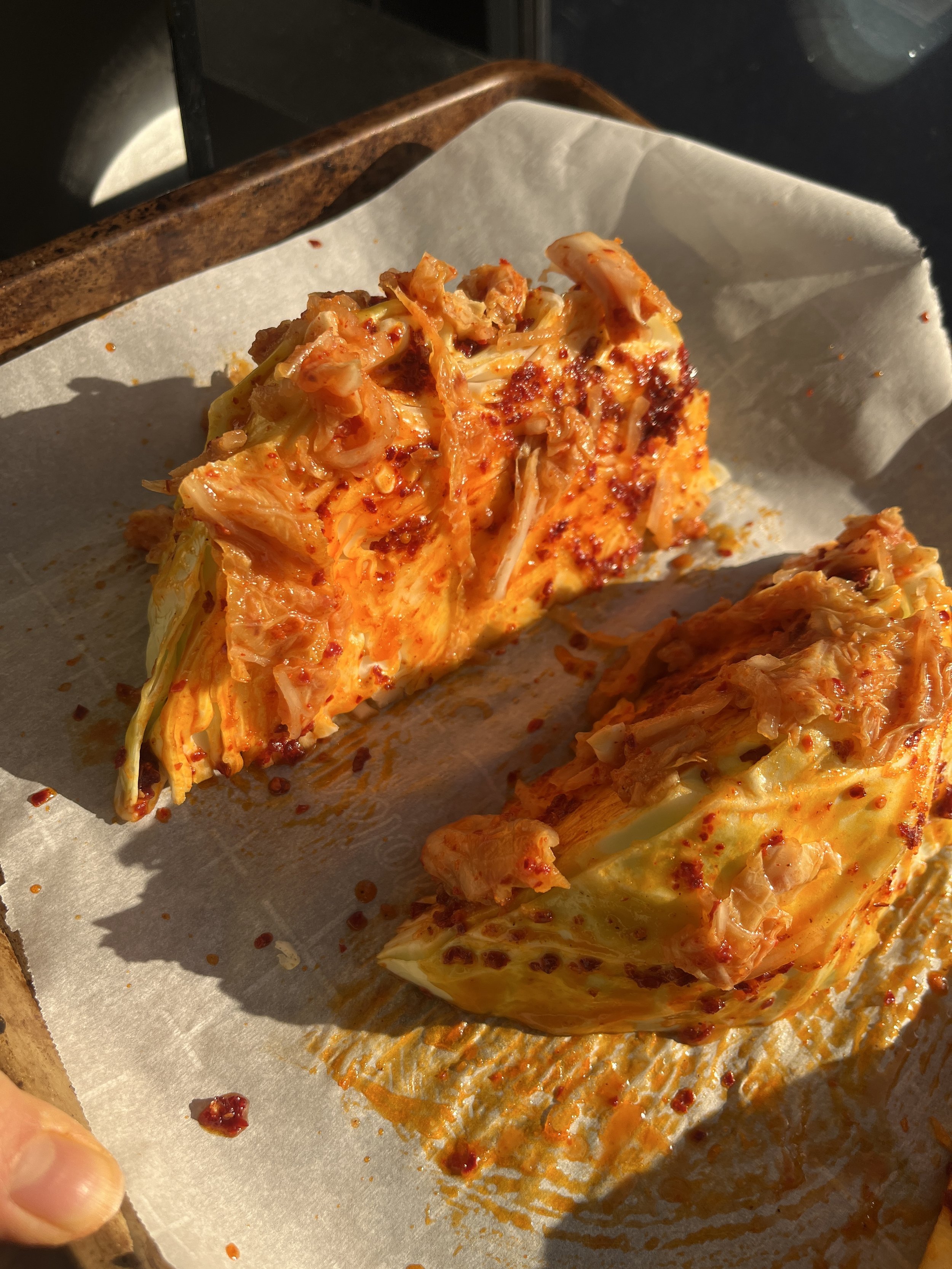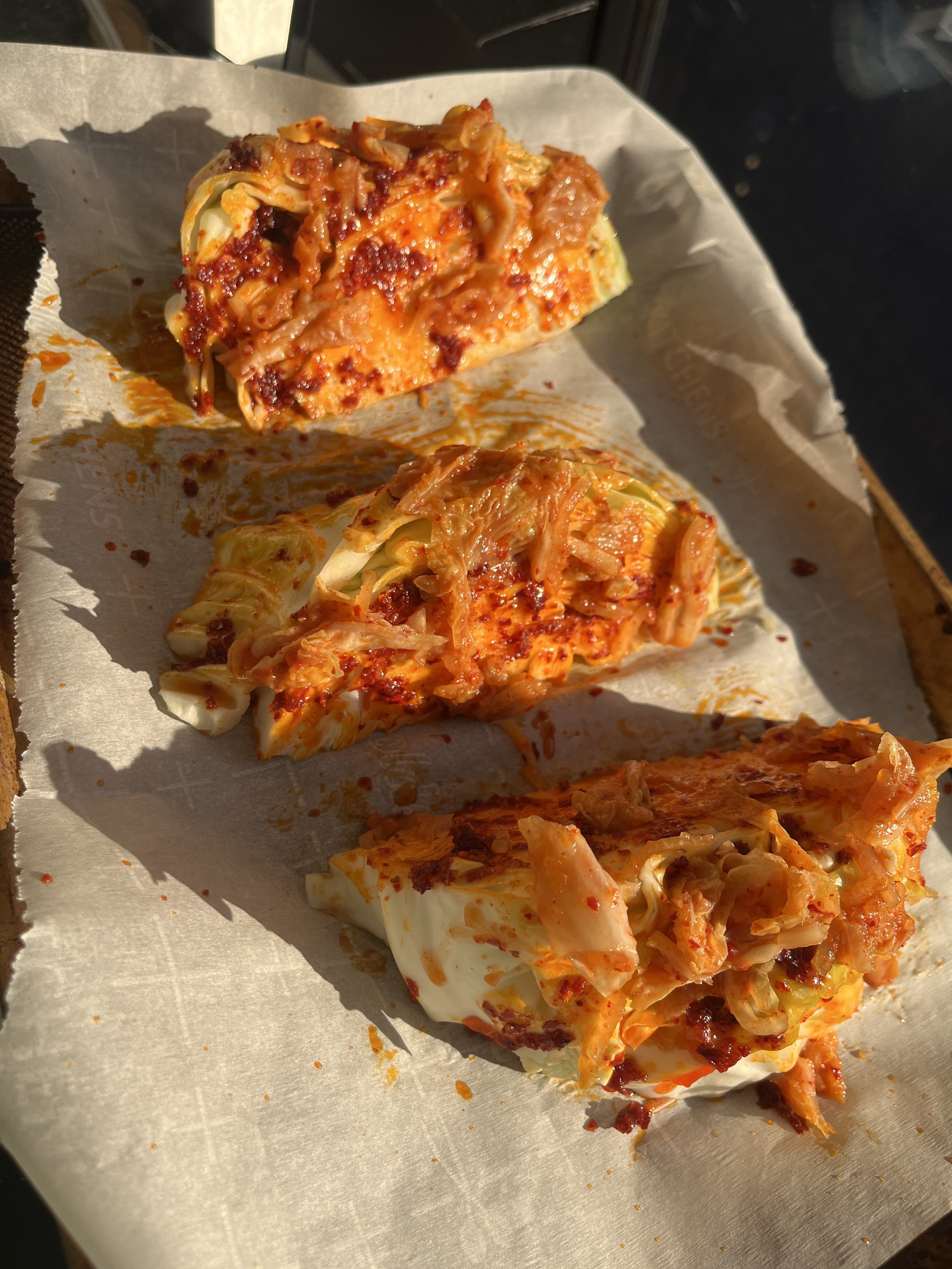roasted cabbage with gochugaru-brown butter
my food isn’t fusion. my food just makes sense.
skip to: non-negotiables, try experimenting with, food styling tips, recipe development notes
Active Time: 15 minutes
Total Time: 45-60 minutes
Servings:
As a main dish, 2 servings (and 1 smaller serving of leftovers for lunch).
As a side dish, 4+ servings.
Ingredients:
½ head of a big, green cabbage
4 tbsp butter (½ stick)
1 tbsp coarse gochugaru
1 tbsp mirin
1 tbsp sesame oil + more for drizzling
~1-2 tbsp old (!) kimchi (or lemon squeeze; see try experimenting with)
honey or hot honey
sesame seeds
Recipe:
1. Preheat oven to 375 F.
2. Browning the butter — First, separate the butter into 1 tbsp blocks. Partitioned blocks will ensure even browning. On low-medium heat, then melt butter in a small pot. Grab the pot handle and swirl.
Close your eyes, and listen to the crackles. . . ( ˘ ³˘) ♫°。♬⋆⸜♪ ✩
In a few minutes, the butter will start foaming, and your kitchen should become fragrant. Brown specks (milk solids!) will start to appear. Using a spoon, mix the butter continuously to prevent the brown specks from sticking to the bottom of the pot. The color will turn amber brown.
At this point, you will be tempted continue browning and perfuming your kitchen. Do not fly too close to the sun. Remove the pot from heat, and pour brown butter into small bowl. Using the same spoon, scrape any brown specks (off the bottom of the pot) into the small bowl as well.
Yes, use another small bowl. I know, my first thought is just to add the rest of the ingredients directly to the pot. However, if you do, your butter will burn. (Brown butter continues to brown on residual heat!) The mirin will start deglazing the pot instead of caramelizing the cabbage. Sesame oil also has a relatively low smoke point. The gochugaru might burn, instead of bloom.
You know I hate doing dishes, and so I do try to use extra dishes as sparingly as possible in my recipes. So, when I call for another bowl, I mean it.
3. Let the brown butter cool for 1-2 minutes.
Take this time to cut your cabbage into 2-3” wedges. 1/2 head of cabbage should give you four 2-3” wedges. Then cover a baking sheet with parchment and lay the cabbage wedges on top.
I hate recipes that tell me to wait (and not give me something to do in the meantime!)
4. To the small bowl, add gochugaru, mirin, and sesame oil. Mix.
5. Brush brown butter mixture on cabbages (cut-face and side/outermost leaf).
It doesn’t really matter if you brush the underside of the cabbage. You can if you want though.
If you don’t have a brush, it’s OK. Just use a fork or spoon to try and distribute the gochugaru-brown butter as evenly as possible.
6. From your kimchi container, pick out thinner, web-like kimchi pieces and any julienned radishes pieces. Lay these kimchi pieces on top of cabbage.You don’t need a lot, just enough to scatter on top of the cabbage.
I am being very particular about the thinner pieces of kimchi (as opposed to the pieces that contain the more meaty, cabbage ridges) for a reason. The thinner pieces caramelize and crisp up. (Thicker pieces will not caramelize and look bulky.)
7. Drizzle with a lil more sesame oil on the cabbage.
8. Roast for 30-45 minutes.
After 30-45 minutes, you can turn off the heat and keep the cabbage in the warm oven until serving.
I think that the longer the cabbage stays in the hot or warm oven the better. Extra time just gives the more meatier parts of the cabbage more time to caramelize.
9. Sprinkle toasted sesame seeds. Drizzle honey (or hot honey!) on top. Voila vegetables!
Non-negotiables
Gochugaru - You have my blessing to riff on the recipe with your favorite pepper flake next time, but for your first time, please use gochugaru. Gochugaru flakes are Korean red pepper flakes that are slightly smoky and sweet. They are not too hot, and they are irreplaceable in my books.
Don’t even think about reaching for that tub of gochuJANG. It’s not the same. It will overpower the brown butter and therefore negate the whole point of this recipe. (Read more about why I picked gochugaru > gochujang in test #1.)
If I am requiring you to buy a whole bag of gochugaru, then I should also tell you how to keep and use the rest of your bag of gochugaru! Store it air-tight the freezer, so that it stays fresh. You can make: kimchi! kkadugi! Add it to your stews and dumpling dipping sauces. Eric Kim has an easy gochugaru salmon recipe. Maangchi has an even simpler salad dressing recipe.Brown butter - If the ingredient are in recipe title….then it is probably integral to the recipe.
Honey - The honey really rounds the flavors out at the end.
Try experimenting with
She’s got range — This cabbage can be served as a steak-like vegetarian main (eaten with fork and steak knife) or warm vegetable salad side (chopped and tossed). Perhaps on day three of leftovers, you can chop the cabbage and throw it into kimchi bokkeumbap (fried rice).
Kimchi v. lemon squeeze — If you don’t have any kimchi, a lemon squeeze right before eating should provide some acid…..it’s not a substitute for kimchi’s tang, char, and caramelization….but it’s an acceptable alternative. I write more about kimchi v. lemon in test #1.
Food styling tips
Texture - The browned edges of cabbage will provide a great base of texture for the eye. The caramelized, web-like kimchi pieces add the next layer. The idea now is to layer increasingly smaller textures (scallions, sesame seeds).
Sheen - Not only does the honey round out the flavors, but it also increases the sheen on the cut-face of the cabbage. I like to drizzle the honey perpendicular to the cabbage leaves so that the honey lies on top instead of falling in-between the leaves.
Lighting - Whenever my dish has warm tones, I like to photograph in direct sunlight. Direct sunlight saturates and further warms the dish without any editing needed.
Perspective - Flat-lays and macro shots will give great close-ups on the dish’s texture. Portrait shots will emphasize the height of the cabbage. See how I photographed a different cabbage dish here.
Recipe Development Notes
It’s been more than a year since my last recipe. Last year, when I started to realize that brands were willing to pay me to develop recipes, that this very imprecise knack could bring in extra change, and with so little free time outside of the hospital, I decided to reserve forthcoming recipe development for brand partnerships. I have written elsewhere about allowing myself to embrace a creative identity that I denied myself for so long, to acknowledge that the things I do for fun can be real labor, real work. I wanted to practice valuing my work as creative. (Value in this sense became monetary compensation because unfortunately that is the way world works. This proof also seemed like the most direct rebuttal to the “you’ll never make money as an artist” ringing in my ears.)
I did find some success in brand work last year. I did feel something (read: good) whenever I picked up a gig–brainstorming, drafting, cooking, shooting, and editing. All my work still felt true to myself; I would have produced videos in the same style on my own, but now I had an impetus. A healthy impetus, in fact, that from time-to-time helped counter the anhedonia and defeatism I carried (but was unable to name) for most of last year.
Nevertheless, developing a recipe for a brand did not hit the same as developing a recipe for our community. While it is nice to be recognized by a brand for my work, its intrinsic return does not compare to that of the work I do on my own accord. The difference is that when I develop recipes for me, for us, it builds community. If you have followed me since the beginning, you remember how my recipe development took on its own life through ‘yes Alex,’ ‘no alex’ polls, zany recipe tests, highly-anticipated recipe drops, and then waves of your iterations.
2023 again proved the life that EAC contains on its own. Last year, 2023, the worst of my life, I witnessed how though EAC only returns this kind of life when I simply do it for me…when I share my survival mode meals (e.g., rice, eggs, and kimchi) during my surgery rotation, when I ask you whether or not I should invite my therapist to my pop-up (I did.), or when I take along for my three-borough, Manhattan-Queens-Brooklyn days. When I live out my own life on Everything Alex Cooks, this type of content surprisingly returns the most engagement and the most intrinsic return for me—incomparable to that of brand work. It is a paradoxical concept to grasp…that somehow when I do things for myself, that when I document unproduced, silly narratives of my days–it also generates community. I do not understand how it works frankly. But there is some generative spirit of Everything Alex Cooks that feeds everyone.
TL;DR Everything Alex Cooks is an energy source, protective behavior, and reminder of better times passed and to come. So, this year, I want to do more recipe development for me, for us, again. Let’s feel something (read: good) together.
Test #1 - February 21, 2024
I’m not a fan of cabbage. Unadulterated cabbage is bitter and tough. I will not buy cabbage willingly. It is probably one of my least favorite vegetables. I know this is surprising, especially considering…kimchi is, well, cabbage. In my humble opinion though, kimchi is not cabbage. Kimchi is the result of when you ferment the sht out of cabbage, douse it in salt, spice, and shrimp paste, allowing new dominant species–Leuconostoc, Lactobacillus, and Weissella–to proliferate. Other forms of adulterated cabbage I can palate? KFC coleslaw or dumpling filling.
Back in December, I received a cabbage in my Local Roots CSA box (kindly #gifted). I dislike cabbage, but I dislike food waste even more. I attempted o get myself excited about cabbage, and so I compiled a list of recipes: Mission Chinese’s Cabbage Salad, Okonomoyaki, Parmesan Cabbage Soup, Roasted Cabbage Caesar Salad. I settled on Melissa Clark’s Roasted Cabbage with Parmesean, Walnuts, and Anchovies. And….boy did I eat my words. Roasted cabbage hit a variety of marks: salt, fat, sweet. Yes ,the cabbage managed to caramelize? Not sure where the sugars are hidden in the ruffage….
So,when I received yet another cabbage in a February CSA box, I wanted to try and cook it my way. I find it difficult to describe my food. It’s Korean-ish. But I would never call it fusion. My food just makes sense.
My food is roasted cabbage with gochugaru-brown butter. I thought brown butter would complement the caramelization and gochugaru would provide a nice sweet, smoky kick. I chose gochugaru over gochujang because 1) I thought gochujang’s higher sugar content might burn 2) I wanted to bathe the cabbage, rather than glaze it.
I tested this batch with and without kimchi on top. I was worried the kimchi would burn. Whenever I make my kimchi focaccia, I notice that the kimchi often burns. It is not inedible, but I’ve noticed that when it chars too much, it loses its acidity. Focaccia cooks around the same heat for half the time as roasted cabbage, so the odds are burnt kimchi were high.
I also wanted to test the recipe with/without kimchi to see if the recipe really required it. Can we get a tang just with a lemon squeeze or do we really need the leuconostoc, lactobacillusm and weissella? To be completely honest, I was hoping the lemon squeeze would suffice. Kimchi is widely accessible these days, but its taste varies depending on age and maker. (You’re only supposed to cook with old kimchi! And I’ve tried that kimchi from Wh*le F**ds. It’s not just “not good”...it’s weird.) Introducing kimchi would introduce variability in the recipe. With the otherwise simplicity of recipe, I felt like the variability of kimchi could negate the recipe’s reproducibility.
What I did right - OK, team kimchi won. My roommate Jenn and I both preferred the one with kimchi.While the lemon squeeze provided fresh acidity, the kimchi provided tang and additional caramelization and char.
Needs improvement - Jenn and I both noted that the cabbage was a little too buttery.
Test #2 - February 29, 2024
I only used half the head in the first test, knowing probably this recipe would require another iteration. This time, I used three tbsp of butter, instead of four. Three tbsp, however, barely covered all the cabbage. I topped all the wedges with kimchi. I added hot honey and sesame seeds to garnish, elevating the sheen and rounding out the flavors.
I also wanted to play around more with….the actual act of eating this dish. The main idea is to eat the roasted cabbage like a vegetarian steak with a fork and knife. But I found this method to be awkward and tiring. The cabbage is taller than a steak, so the ergonomics of your elbows are angled upwards. It was also mentally taxing: I felt as though I was calculating the optimal size to cut each bite. Sometimes a bite would be too small, sometimes too large. After a few rounds of leftovers, I found that I actually prefer the recipe as a chopped side salad. I simply cut up the wedge with a pair of scissors. It is much easier to eat with rice/noodles and/or protein.
What I did right - I like how the leftovers allowed me to continue to tinker with the recipe. I added and swapped garnishes. I took pictures in direct and indirect light. I ate the meal as lunch, linner, and dinner. I think these additional “tests” speak to the versatility of this dish–whether a side or main, alongside rice noodles, and/or protein, enjoyed with fork and knife or chopsticks.
If you decide to test this cabbage, please tag me @everythingalexcooks, I want to see your creations and hear your thoughts!













